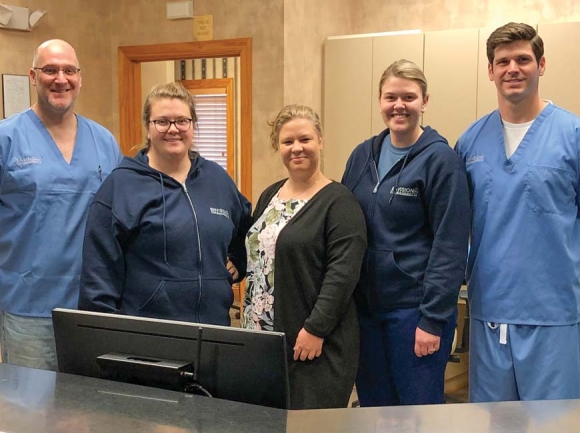Envision Pain Management opens in Clyde
 The staff at Envision Pain Management Dr. Travis Hecker, (from left) Autumn Davis, Crystal Maine, Kristen Townsend and Dr. Daniel Atkinson prepare to welcome new patients after first opening in Clyde. Jessi Stone photo
The staff at Envision Pain Management Dr. Travis Hecker, (from left) Autumn Davis, Crystal Maine, Kristen Townsend and Dr. Daniel Atkinson prepare to welcome new patients after first opening in Clyde. Jessi Stone photo
For years opioids were overprescribed by physicians and overused by patients, leading to skyrocketing rates of addiction, overdoses and drug-related crime. Now that the issue has risen to the level of a national public health and safety crisis, society is more aware of the dangers associated with opioid abuse and physicians are learning new ways to manage patients’ pain levels.
Meanwhile, pain management specialists are dealing with the backlash and trying to maintain a delicate balance between adhering to the new standards surrounding prescribing these drugs while also making patients understand that opioids still have a proper place when it comes to treating chronic pain.
A new freestanding pain clinic recently opened in Clyde — Envision Pain Management — and providers Dr. Travis Hecker and Dr. Daniel Atkinson took the time to sit down with The Smoky Mountain News to talk about the stigmas associated with opioids and other forms of pain treatment that have proved successful.
Understanding pain
“Pain management is still a relatively new field — it’s only been around 20 years or so and it’s still poorly understood,” Hecker said.
Hecker worked at a private practice in Bryson City a few years back and realized how underserved the region actually is when it comes to any specialties, let alone pain management. After heading back up north, he started making plans to return to Western North Carolina with a clinic to meet those needs in the community.
Related Items
“What’s unique about this clinic is it is the largest freestanding pain clinic in Western North Carolina and that’s crucial because you can get services at a significantly cheaper rate but at the same level of care as you would in a hospital setting,” he said.
All physicians used to deal in pain management for their patients whether it was the primary care doctor or a surgeon, Hecker said, until they realized it really demanded its own specialty. That’s why he said it’s so important for Envision’s providers to be board-certified pain specialists.
“The training we have is comprehensive — medication, procedures and other resources as well as behavioral health and mental health evaluations,” he said. “Pain management is still done in primary care offices, but many times they don’t approach it from a comprehensive perspective. Behavioral health issues with pain complaints are definitely under-recognized.”
Treating and managing pain is not always a quick process — it can take months to find the right treatment for an individual. So many patients experiencing pain don’t see a doctor because of financial hardships or maybe they’re primary care doctor can’t find a proper diagnosis. Either way, people end up self-medicating with drugs and/or alcohol to deal with the discomfort. Meanwhile the pain gets worse overtime. With a better education about pain and successful treatments, Hecker hopes to find more people the long-term relief they’re seeking.
“When you’re in pain you can also suffer from anxiety and depression because maybe you can’t sleep and you have a loss of function, which impacts your mental health — it’s all connected. There’s also the socioeconomic factors like a significant history of abuse, poverty, tobacco use and all that needs to be treated to have the best chance for a positive outcome,” Hecker said.
Atkinson agreed that no matter someone’s socioeconomic status, those dealing with chronic pain are also likely coping with depression and anxiety.
“There’s going to be a lot of layers that have to be unwrapped,” he said.
Atkinson was originally trained in anesthesia, but he said he missed the patient interaction.
“You get to see patients on the floor before a procedure but it’s short term. You don’t get to see the result and response — that’s the puzzle piece I was missing. I like the procedure side of things and impacting their lives,” he said.
“I think if you talk to more anesthesiologists they’ll all say that. They’re experts in opioids and pain but it’s the patient experience we miss,” Hecker said. “It’s been a natural translation to pain management. It’s a good fit because we really understand opioids and pain and we can bring all of it together.”
Opioid-sparing treatments
Pain management can take many different forms at Envision Pain Management. Hecker said the clinic provides leading-edge minimally invasive operative, procedural and non-operative pain care with the most current FDA approved therapies.
The clinic offers standard joint, knee and shoulder injections, but also have the ability to offer spinal cord pumps, an implantable pain management system that can relieve neuropathic pain when oral medications don’t work and surgery has been ruled out.
For non-operable back pain, the clinic can offer VertiFlex, a procedure for treating spinal stenosis pain with an implanted device called the Superion — an “H” shaped spinal spacer.
“With Superion, there’s probably two or three doctors in Western North Carolina that can do that procedure and I’m one of them,” Hecker said.
Perhaps one positive to come out of the opioid crisis and stricter regulations surrounding prescriptions, is a broader look at pain management and a focus on developing “opioid-sparing” treatments like the ones offered at Envision. Hecker said 15 years ago the government was paying physicians based on their patient satisfaction scores, which made doctors more inclined to prescribe opioids to quickly get pain levels down. With what is now known about opioids, the medical community came to understand that was not a successful model.
“It’s been good to put the spotlight on opioids because it’s forced us to look at other ways — it’s shifted the pendulum,” he said. “Opioids have been the mainstay of pain management for years, but over time we’ve discovered two things: we’ve had a poor understanding of chronic pain, and opioids in general for a majority of people don’t work and have significant risks associated with them.”
What he’s seen happen to so many people is that they were overprescribed opioids for a short-term pain from an acute injury or surgery and ended up with an addiction. Without affordable access to behavioral health services and specialties like physical therapies or the more advanced pain management treatments, Hecker said it makes sense how the opioid problem has spiraled out of control in the region for years.
“They get started for acute pain and transition to long-term opioid use. In this region there hasn’t been a lot of focus on physical therapy or specialty care — so when opioids are the only tool you have that’s what you use,” he said. “In reality, the percentage of people that get addicted to opioids is small. The people that become dependent on them is high and people who become tolerant of opioids is high. Tolerance and dependence will happen — addiction may happen.”
Future of opioids
Despite the risks, Hecker said opioids still have a rightful place in pain management for patients suffering from certain chronic conditions whether they have cancer or a terminal disease or other procedures have proven unsuccessful. When the goal is to get patients back to a good quality of life, Atkinson said it’s all about evaluating the potential risks and benefits of using opioids and continually monitoring the patient’s progress.
“Yes, there’s probably a pool of patients that will need opioids to function and sleep, which is why evaluating who that is takes time and specialty training,” he said. “We offer many modalities and sometimes that does include opioids.”
Hecker’s and Atkinson’s hope is that patients will come to the clinic for treatment before their condition becomes more serious. Once it becomes chronic pain, it’s most likely a pain that has to be managed over the course of someone’s life through physical, behavioral and medical procedures.
“Some patients have acute problems, and if we can evaluate it quickly we hope to stop it from becoming chronic,” Hecker said. “For patients who’ve had pain for a long time, we have to dig in and find the source, get a diagnosis and shift them back to recovery.”
Atkinson said there’s a website now that allows the state to monitor the number of opioids being prescribed by physicians. It also allows physicians to keep an eye on their prescribing track record and alerts them to any red flags that should be amended.
“There’s still a lot of confusion surrounding new laws and I think there’s some scare tactics going on with some physicians who think if they’re not a pain physician they can’t prescribe narcotics,” Atkinson said. “I get a lot of referrals from people thinking they can no longer prescribe, but they can.”
The three biggest pain complaints they expect to treat are headaches, hip pain and joint pain. While Envision will take walk-ins to the clinic, Hecker said they prefer to take referrals and take a collaborative approach along with the patient’s primary care doctor.
Right now the clinic has two providers and six employees total. They anticipate needing eight or nine employees as new patients are added. In the next six months, Hecker said they hope to have three to four locations established in the region to improve access for patients. For more information, call 828.237.8001 or visit www.envisionpainmanagement.com.













